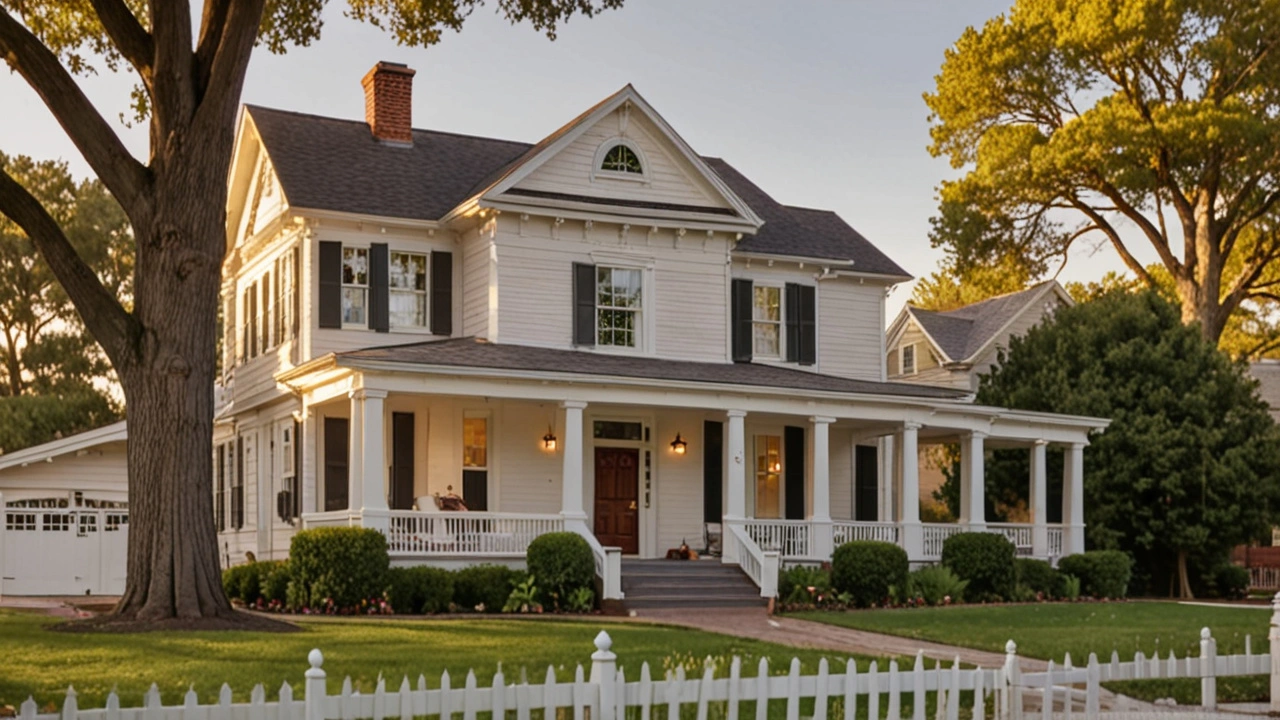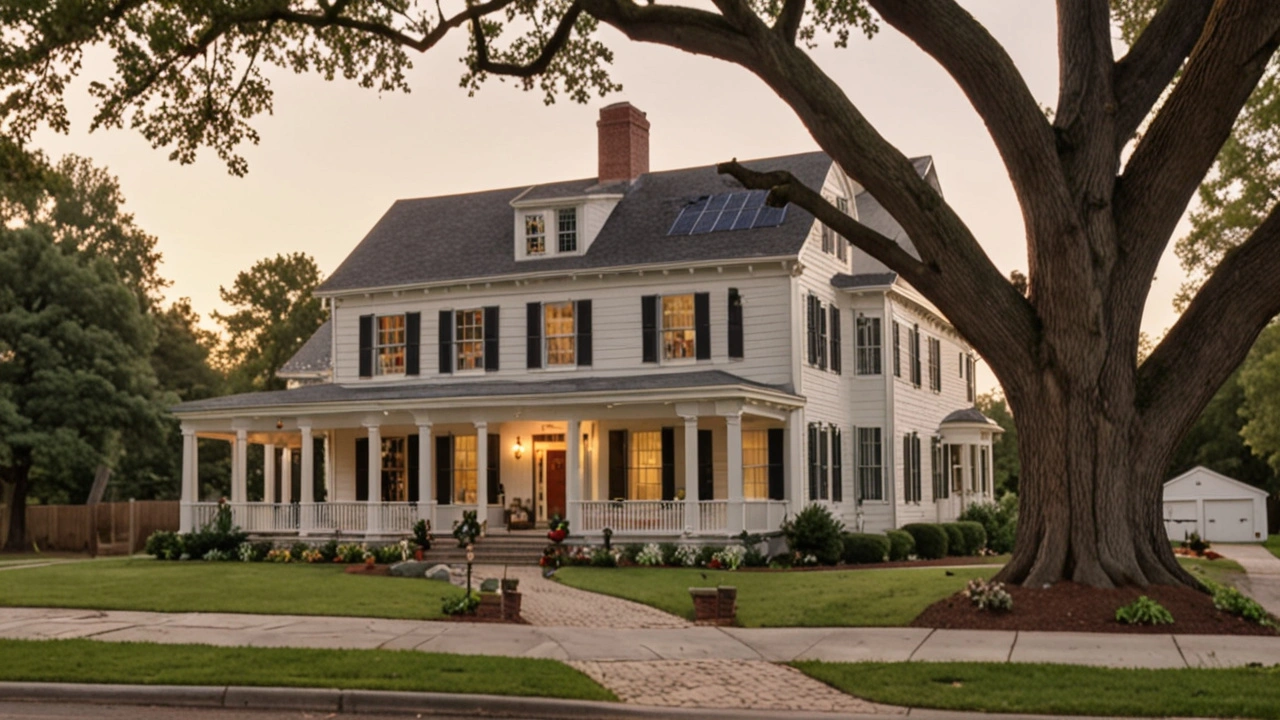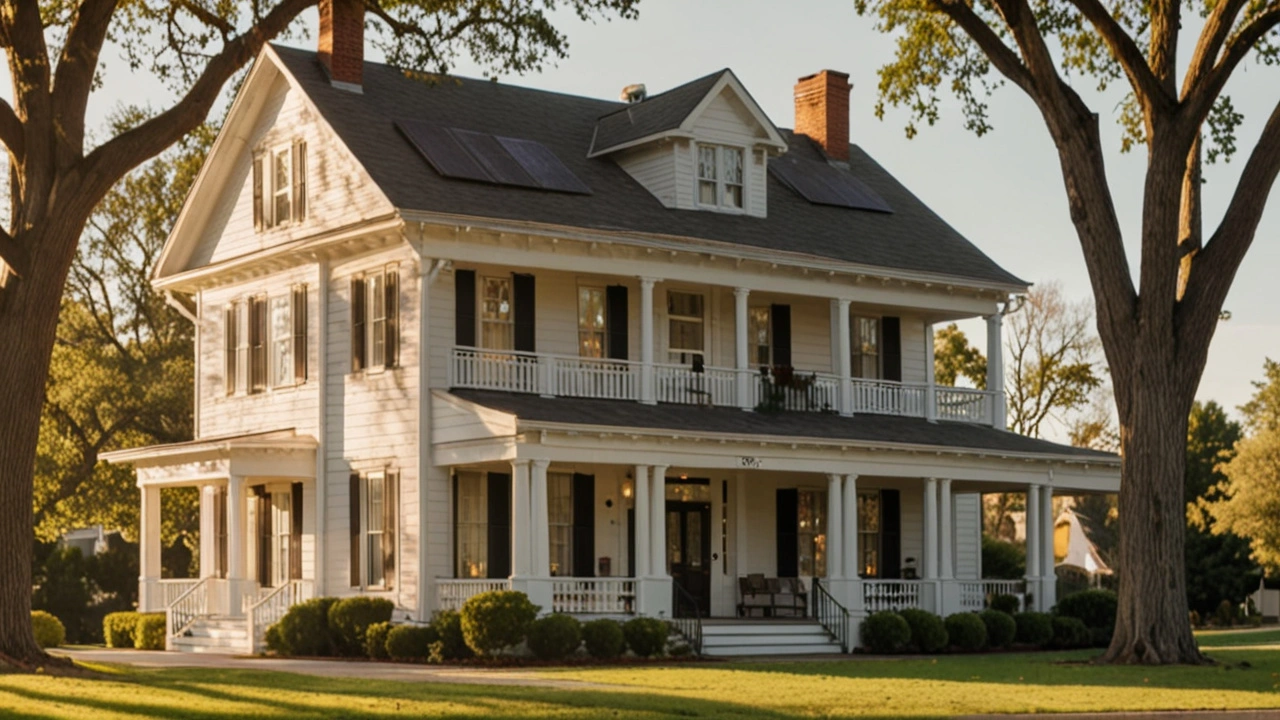Colonial Revival Architecture: A Timeless American Tradition
 Jul, 16 2024
Jul, 16 2024
Colonial Revival architecture is more than just a style; it's a nod to America's design heritage. Emerging in the late 19th century, this style aimed to celebrate and reinterpret early American colonial architecture, adapting it to contemporary needs while preserving its historical essence.
Whether it's the symmetrical façades or the classic decorative elements, Colonial Revival homes evoke a sense of timeless elegance that continues to captivate homeowners and architects alike. This article will explore the intriguing journey of Colonial Revival architecture, highlighting its unique features and enduring popularity.
- The Origins of Colonial Revival
- Key Characteristics of Colonial Revival
- Famous Examples of Colonial Revival Architecture
- Why Colonial Revival Endures
- Tips for Embracing Colonial Revival in Modern Homes
- Resources for Further Exploration
The Origins of Colonial Revival
Colonial Revival architecture emerged towards the end of the 19th century as part of a broader American cultural movement. After the Centennial Exhibition of 1876 in Philadelphia, there was a renewed interest in the nation's colonial past. The exhibition featured numerous displays celebrating early American heritage, sparking a sense of nostalgia among visitors and inspiring architects to revisit colonial architectural styles.
This movement wasn't just about aesthetics; it reflected a desire to return to what many saw as the purity and simplicity of earlier times. The country was rapidly changing with urbanization and industrialization, and Colonial Revival architecture offered a comforting reminder of an idealized rural and pre-industrial past. Prominent figures in the movement, like architects McKim, Mead & White, drew inspiration from true colonial buildings but adapted them to contemporary needs and technologies.
Interestingly, Colonial Revival architecture wasn't limited to merely copying colonial designs. Instead, it reinterpreted them, blending details from different colonial periods and regions into cohesive, aesthetically pleasing structures. For example, Georgian and Federal styles were often combined to create a modern yet historically rooted appearance. This eclectic mix resulted in a new style that revered historical accuracy while allowing for artistic freedom.
The early 20th century saw a significant surge in the popularity of Colonial Revival architecture. Residential neighborhoods and public buildings alike embraced the style. The architecture boom during the 1920s cemented Colonial Revival as a quintessential American style. Real estate developers and homebuilders favored it for its broad appeal and versatility, making it a predominant choice in suburban developments.
According to architectural historian Richard Guy Wilson, “Colonial Revival is not simply stylistic nostalgia but reflects social and cultural identity. It's about who Americans perceive they are and where they come from.”
It's also worth noting that the Colonial Revival movement paralleled other revival movements, such as the Tudor Revival and Neoclassical Revival, which all sought to evoke different aspects of historical architectural beauty. However, no other revival style captured the American spirit quite like the Colonial Revival, which managed to resonate deeply with the patriotic sentiments of the time. This style remained popular, evolving with changing tastes and economic conditions but never straying too far from its roots.
The rise of Colonial Revival architecture wasn't just happenstance. It was a conscious effort to forge a link between America's colonial heritage and its burgeoning modern identity. By embracing elements like symmetrical façades, gable roofs, and classical columns, the Colonial Revival style created homes that were not only beautiful but also symbolically rich. As we delve deeper into the specifics of this enduring architectural style, it's essential to keep its historical context in mind, understanding how it reflects broader societal trends and cultural movements.
Key Characteristics of Colonial Revival
When you think of Colonial Revival architecture, several key elements likely come to mind, each contributing to this style's iconic appearance. One of the most notable features is the emphasis on symmetry. Whether it's the placement of windows, doors, or even chimneys, everything is meticulously balanced. This symmetry gives Colonial Revival homes a stately and orderly presence that many find appealing.
Windows in Colonial Revival homes are typically double-hung with multiple panes, often arranged in two-over-two or six-over-six patterns. These windows are usually evenly spaced and aligned both horizontally and vertically, adding to the overall balanced look of the home. You'll often find decorative shutters flanking the windows, which not only enhance the aesthetic but also serve a functional purpose in their original designs.
The entryway of a Colonial Revival home often acts as a focal point, featuring decorative elements like pediments, pilasters, and transoms. Additionally, the front door is usually paneled and may include a fanlight or sidelights, adding to its grandeur. Some homes even incorporate intricate crown moldings or decorative columns that echo the grandeur of ancient Greek and Roman architecture.
Roofs in Colonial Revival homes are generally steeply pitched and gable-oriented, providing both a dramatic silhouette and practical benefits such as efficient water runoff. While some Colonial Revival homes feature dormers, which add light and space to the upper levels, others may have simple, uncluttered rooflines.
Another defining feature is the use of brick or wood siding. Early Colonial Revival homes often borrowed from the Georgian and Federal styles, utilizing red brick façades with white wooden trim. In some cases, the siding may be clapboard or wooden shingles that are meticulously painted and maintained to preserve the historic look.
The interior of Colonial Revival homes often reflects the same orderly elegance found on the exterior. Rooms are typically organized in a center hall floor plan, promoting a sense of spaciousness and flow. Molding, wainscoting, and intricate woodwork abound, adding a layer of sophistication and historical authenticity.
According to the National Trust for Historic Preservation, "Colonial Revival architecture is not just about recreating the past; it's about adapting it to modern sensibilities while retaining the charm and character that made it appealing in the first place." This sentiment is evident in how contemporary architects and homeowners continue to incorporate colonial elements into modern designs, blending old-world charm with modern comfort and functionality.
The use of traditional materials such as wood, brick, and stone further reinforces the historical accuracy of Colonial Revival homes. Attention to detail in craftsmanship, from hand-carved woodwork to meticulously laid brickwork, ensures these homes are as durable as they are beautiful. Modern materials and techniques can also be employed to enhance energy efficiency and sustainability, making it possible to enjoy the best of both worlds.

Famous Examples of Colonial Revival Architecture
One of the most vibrant examples of Colonial Revival architecture is the Williamsburg Inn in Virginia. Built in the 1930s, this grand hotel aimed to replicate the elegance of early American homes while offering modern luxuries. The symmetrical façade, grand entrance with classical columns, and intricate brickwork perfectly embody the Colonial Revival spirit. The Williamsburg Inn has stood the test of time, providing a glimpse into America's design past while catering to today's comfort needs.
Another notable example is the Washington National Cathedral in Washington, D.C. Completed in 1990, this enormous structure is an imposing take on Colonial Revival style, featuring intricate stonework, soaring spires, and stained glass windows that captivate countless visitors each year. It's both a place of worship and a historical landmark, bridging the past with the present in a way that is truly awe-inspiring. Architect Henry Vaughan, one of the key figures in its design, once said, "A church is not merely a building; it is a living testament to the history and faith of a community."
The Westover Plantation, also located in Virginia, showcases Colonial Revival architecture on a more intimate, residential scale. Built by the Byrd family in the mid-18th century, it is a splendid example of a Southern plantation home featuring the classic symmetrical design, expansive gardens, and stunning waterways. It is a favorite spot for history buffs and architectural enthusiasts alike, as it offers rich stories of America's past within its charming, historical walls.
For a more urban example, the Hahnemann Hospital in Philadelphia combines modern functionality with Colonial Revival aesthetics. When it opened in 1928, the hospital's design included large, airy rooms, wide staircases, and a classic brick and stone exterior that radiates a sense of strength and stability. Its long-standing reputation as a top medical facility also underscores how Colonial Revival architecture can fuse practicality with beauty.
Walking through neighborhoods in places like Georgetown, Washington D.C., or Beacon Hill, Boston, you'll find countless residential examples. These homes, often updated for modern living, retain their symmetrical layouts, gabled roofs, and columned porches. They provide not only aesthetic pleasure but also a tangible connection to America's architectural roots. Realtor Jane Ferguson remarks, "Homes in these neighborhoods offer more than just curb appeal; they offer a piece of history."
In examining these famous examples of Colonial Revival architecture, one can't help but appreciate the versatility and timelessness of this style. From grand hotels and churches to intimate homes and public buildings, Colonial Revival architecture serves as a timeless reminder of America's rich and diverse architectural heritage.
Why Colonial Revival Endures
Colonial Revival architecture has maintained its appeal across decades, drawing admirers for a variety of reasons. From its classic aesthetics to its practical design elements, the charm of this architectural style is deeply rooted in both its historical significance and its adaptability to modern living.
One significant reason Colonial Revival endures is the connection it provides to America's past. Originating in the late 1800s, this style emerged as a way to foster national pride by recalling the colonial era. The return to symmetrical lines and classical proportions was a symbolic nod to the values and traditions of early American settlers. Today, these homes evoke a sense of nostalgia, offering a tangible link to history that many find comforting and inspiring.
Another reason for its enduring popularity is the versatile nature of the style. Colonial Revival homes often feature a symmetrical façade, gabled roofs, and multi-paned, double-hung windows, which not only create a pleasing aesthetic but also offer practical benefits. The use of local materials and straightforward construction methods make these homes both durable and adaptable to different climates and landscapes across the United States. This flexibility ensures that Colonial Revival homes remain relevant and desirable in a variety of settings.
Additionally, the style's ability to incorporate modern conveniences while preserving its timeless look is a key factor in its ongoing appeal. Many homeowners are drawn to the balance of old-world charm with contemporary functionality. For example, it's common to find Colonial Revival homes with open floor plans that cater to modern lifestyles but maintain the traditional exterior design elements that define the style. This blend of the old and the new allows for a harmonious living experience that caters to present-day needs without sacrificing historical authenticity.
Another compelling aspect is the craftsmanship inherent in Colonial Revival architecture. The attention to detail and quality of construction are hallmarks of this style, which are highly valued in today's market where mass-produced, cookie-cutter homes are prevalent. Homebuyers seeking unique, well-crafted properties often gravitate towards Colonial Revival homes for their character and superior build quality.
"Colonial Revival homes are the epitome of timeless design. Their clean lines and classic proportions strike a perfect balance between beauty and functionality," says architectural historian, Jane Smith.This focus on detail and durability means that Colonial Revival homes not only look beautiful but also stand the test of time, making them a wise investment for the future.
Lastly, the sense of community and heritage that surrounds Colonial Revival neighborhoods contributes to their lasting appeal. These areas often boast tree-lined streets, well-maintained lawns, and a cohesive aesthetic that adds to the overall charm and desirability of the location. Living in a Colonial Revival home is not just about the house itself, but also about being part of a community that values history, beauty, and tradition.
In summary, the enduring popularity of Colonial Revival architecture can be attributed to its historical significance, versatile design elements, ability to blend old and new features, superior craftsmanship, and the sense of community it fosters. These factors combined ensure that this architectural style remains a beloved choice for homeowners across America.

Tips for Embracing Colonial Revival in Modern Homes
Embracing Colonial Revival architecture in your modern home is like adding a touch of historical elegance to contemporary comfort. This style isn't only for vintage structures; it can be effortlessly integrated into today's homes with a few thoughtful touches. Start with the exterior. Opt for a symmetrical design if you are planning a new build. Symmetry and balance are hallmarks of Colonial Revival homes, so focus on a centered front door flanked by evenly spaced windows.
When it comes to materials, brick, wood, and stone are excellent choices. These sturdy, traditional materials not only evoke the charm of Colonial-era homes but also promise durability. An inviting front entrance is crucial. Use a classic six-panel door, and consider adding sidelights or a decorative crown. Historical accuracy can truly transform the façade of your home.
As you move indoors, look at keeping the floor plan simple and structured. Colonial Revival interiors are known for their practicality and elegance, often featuring central hallways that lead to various rooms. Include wooden wainscoting and ornamental crown moldings to bring in that authentic feel. Don't overlook the power of traditional colors. Go for a classic palette—think muted blues, greens, and earth tones that were historically popular.
Furnish your home with antiques or replicas that mirror Colonial designs. A four-poster bed, Chippendale chairs, or a sturdy mahogany dining table can elevate the theme. Lighting also plays a key role. Brass chandeliers and sconces with simple lines can perfectly complement the Colonial Revival aesthetics. These fixtures not only illuminate your space but also add to the historic ambiance.
Incorporate elements like built-in bookshelves and fireplaces. A fireplace with a simple mantel can be the focal point of a living room, inviting warmth and coziness reminiscent of Colonial homes. Gardens and landscaping should not be neglected. A tidy, well-kept garden with neatly trimmed hedges and colonial-style fences can enhance the overall look of your home.
"Colonial Revival homes are about more than just symmetry and materials; they embody a sense of history and American tradition," says historian Jonathan Henderson. His insights remind us that this architectural style is deeply rooted in our cultural heritage.
If you are renovating an older home, try to preserve as many original features as possible. These can be the heart and soul of your home's historical character. If the home’s original floors or doors are salvageable, refurbish rather than replace them. Often, these elements carry a unique charm that new materials can't replicate.
Finally, don't be afraid to mix old and new. While it’s important to maintain the Colonial Revival integrity, you can also introduce contemporary elements like modern appliances or smart home technologies. Blend these seamlessly into your design to have the best of both worlds. Embracing Colonial Revival in a modern setting is a rewarding way to honor America’s architectural past while enjoying the conveniences of today.
Resources for Further Exploration
Exploring the realm of Colonial Revival architecture can be an intriguing journey. Whether you’re a homeowner looking to incorporate its timeless charm into your house or simply an enthusiast eager to learn more, there are myriad resources available for deep dives into this architectural style.
Books and Literature
One of the best ways to understand Colonial Revival architecture is through detailed literature. Books such as "A Field Guide to American Houses" by Virginia Savage McAlester provide comprehensive overviews of various American housing styles, including Colonial Revival. Another valuable read is "American Colonial: Puritan Simplicity to Georgian Grace" by Wendell Garrett, which offers a closer look at Colonial architecture’s evolution and its revival.
"Literature presents the foundation of knowledge necessary to fully appreciate the intricate details of Colonial Revival architecture." – Architectural Digest
Museums and Historic Sites
Visiting museums and historic sites can offer firsthand experiences of Colonial Revival homes. The Colonial Williamsburg Foundation in Virginia is an excellent place to start, offering a glimpse into America's colonial past. Historic New England also preserves a significant number of Colonial Revival homes, providing tours and educational programs that highlight their historical and architectural significance. Walking tours in cities like Boston and Charleston can also lead you to beautiful examples of this style.
Online Databases and Websites
In the digital age, numerous online resources can help you delve into Colonial Revival architecture. Websites like the National Trust for Historic Preservation offer valuable information on historic homes and styles across America. The Library of Congress also has extensive archives of photographs, plans, and writings on Colonial Revival buildings.
Courses and Workshops
For hands-on learning, consider enrolling in architectural history courses or workshops. Many universities and colleges offer specialized programs on American architecture, which often cover Colonial Revival. The Institute of Classical Architecture & Art frequently hosts workshops and lectures on historical architectural styles, including chapters devoted to Colonial Revival.
Local Historical Societies
Your local historical society can be a treasure trove of information, often housing archives, photographs, and documents that detail the architectural history of your area. Many societies also organize events such as home tours and lectures, providing unique opportunities to learn about local examples of Colonial Revival architecture.
Embrace these resources to deepen your understanding and appreciation of Colonial Revival architecture. Whether through books, museums, online databases, or engaging in hands-on workshops, each offers a different lens through which to explore and celebrate this enduring American architectural tradition.